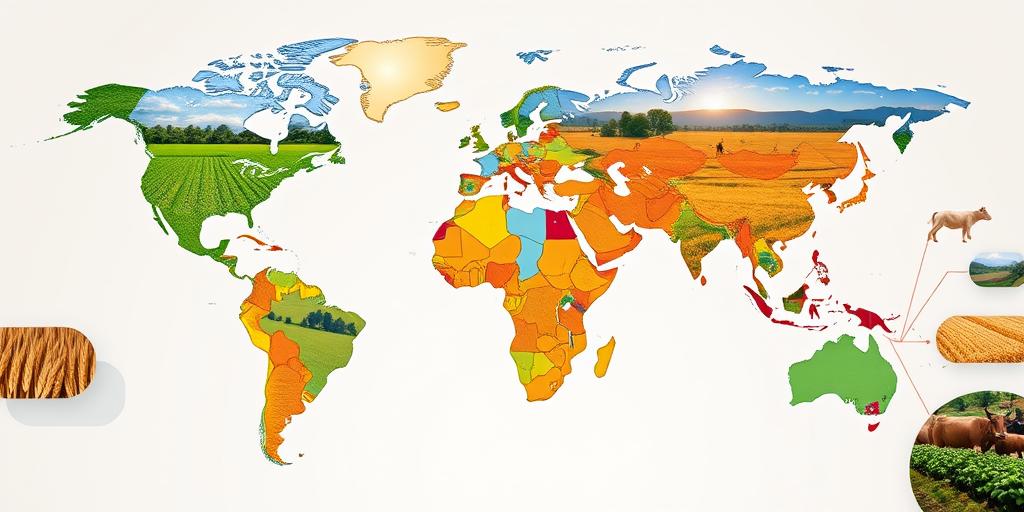The Geography of Agricultural Production and Food Security
Food security, defined as having reliable access to a sufficient quantity of affordable, nutritious food, is inextricably linked to the geography of agricultural production. Understanding the spatial distribution of agriculture, the factors that influence it, and its relationship to food security is crucial for addressing global challenges related to hunger and malnutrition. This article explores the key geographical aspects of agricultural production and their implications for food security worldwide.
Factors Influencing Agricultural Production
Several geographical factors determine the suitability and productivity of agricultural land:
- Climate: Temperature, rainfall, and sunlight are primary determinants. Different crops thrive in specific climate zones, dictating what can be grown where.
- Soil Quality: Soil fertility, texture, and drainage impact crop yields. Regions with fertile soils, such as those found in river valleys, are typically more productive.
- Topography: The slope and elevation of land affect its suitability for agriculture. Flat or gently sloping land is generally preferred for cultivation.
- Water Availability: Access to water for irrigation is essential in many regions, particularly those with arid or semi-arid climates. Rivers, lakes, and groundwater resources play a critical role.
- Land Use and Infrastructure: Land use policies, transportation networks, and storage facilities influence the efficiency of agricultural production and distribution.
Global Distribution of Agricultural Production
Agricultural production is unevenly distributed across the globe. Some regions are major producers of specific crops or livestock, while others struggle to meet their own food needs.
- Major Agricultural Regions: Key agricultural regions include the Great Plains of North America (grain production), the Amazon Basin (soybeans and cattle), the Indo-Gangetic Plain (rice and wheat), and the European Plain (wheat, barley, and oilseeds).
- Regional Specialization: Different regions specialize in producing different commodities based on their comparative advantages. For example, Southeast Asia is known for rice production, while Brazil is a major producer of coffee and sugarcane.
- Challenges in Developing Countries: Many developing countries face challenges in agricultural production due to factors such as limited access to technology, poor infrastructure, and climate vulnerability.
Impact on Food Security
The geography of agricultural production has profound implications for food security. Regions with high agricultural productivity are more likely to have stable food supplies, while those with limited production may face food shortages and dependence on imports.
- Food Deserts: Urban areas with limited access to affordable and nutritious food, often due to a lack of grocery stores or transportation options.
- Food Supply Chains: Complex networks that connect producers to consumers, often spanning vast distances and involving multiple intermediaries.
- Global Trade: The exchange of agricultural commodities between countries, which can help to mitigate food shortages in some regions but also create dependencies and vulnerabilities.
Addressing Food Security Challenges
To enhance food security, it is essential to address the geographical disparities in agricultural production and improve access to food for all populations.
- Sustainable Agriculture: Practices that minimize environmental impact and promote long-term productivity, such as crop rotation, conservation tillage, and integrated pest management.
- Investments in Infrastructure: Improving transportation networks, storage facilities, and irrigation systems to enhance the efficiency of agricultural production and distribution.
- Support for Smallholder Farmers: Providing access to credit, technology, and training to help smallholder farmers increase their productivity and resilience.
- Policy Interventions: Implementing policies that promote food security, such as subsidies for farmers, food assistance programs, and trade agreements that ensure fair access to markets.
Conclusion
The geography of agricultural production plays a critical role in shaping food security outcomes around the world. Understanding the spatial patterns of agriculture, the factors that influence it, and its relationship to food access is essential for developing effective strategies to address global hunger and malnutrition. By promoting sustainable agricultural practices, investing in infrastructure, supporting smallholder farmers, and implementing appropriate policies, we can work towards a more food-secure future for all.









